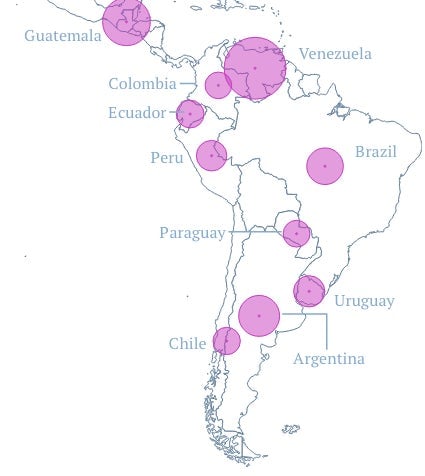Latin America earns more from exporting soccer players than live animals
When a country exports more value in soccer players than in steaks—like, say, Guatemala—it’s probably an outlier. But when almost an entire region exports more money in soccer players than live animals—like, say, Latin America—it’s a trend.


When a country exports more value in soccer players than in steaks—like, say, Guatemala—it’s probably an outlier. But when almost an entire region exports more money in soccer players than live animals—like, say, Latin America—it’s a trend.
Next year’s World Cup is going to be held in Brazil, but the world scarcely needs a spotlight to remind it of how important Latin America is to the global soccer brand. The region’s rich history of soccer greats has brought the world some of its very best players. But while the likes of Pele and Diego Maradona used to play not only for their respective countries’ national teams, but also for their local club teams, the practice is almost unheard-of these days.
For young Latin American soccer prodigies today, it’s not so much a question of whether, but rather when they’ll leave their home countries. Virtually every single Latin American soccer star ships off to play in Europe these days. Lionel Messi, generally considered the world’s best player, did it; Neymar, Brazil’s most recent prize, just did it, too. In the first six months of 2013, the top eleven exporters of soccer players in Latin America shipped off nearly 5,000 soccer players worth over $1.1 billion dollars in total. Argentina and Brazil alone exported over 3,000 soccer players, or over $400 million in soccer talent.
Latin America as a whole exported more value in soccer players in the first half of 2013 than live animals in the entirety of 2011. Argentina’s soccer player exports amount to about a quarter of the value of its meat exports over the same period in 2011; Brazil’s to more than its gun exports; Uruguay’s to more than its fish exports; Peru’s to more than its cocoa exports; and Ecuador’s to roughly the same as its coffee and tea exports. Guatemala even ships off more value in soccer players each year than beef.
Of course, some of the $228 million that Argentina earns from exporting soccer players ends up leaving the country with the players themselves, while the rest mostly goes into the coffers of their former teams. But the sheer number of Latin American players that are shipped overseas each year and soaring market price of their collective talent suggests either that the region doesn’t have enough to offer them at home, or needs to be exporting a lot more of other things.